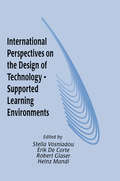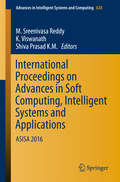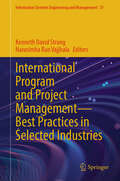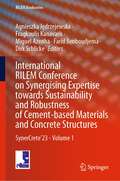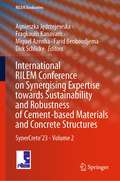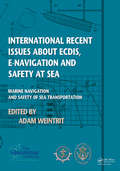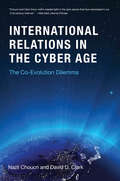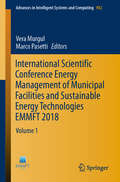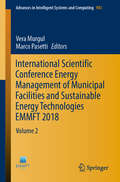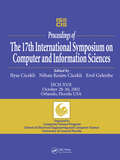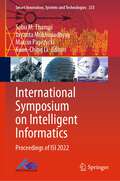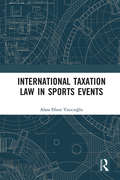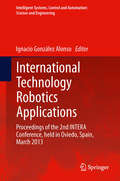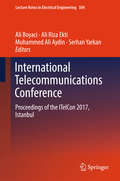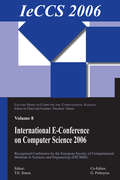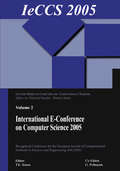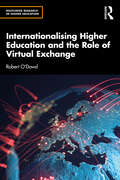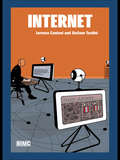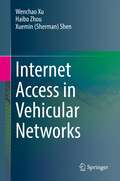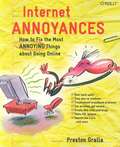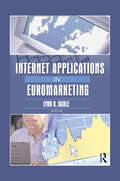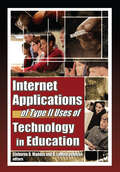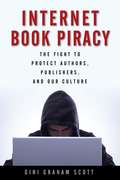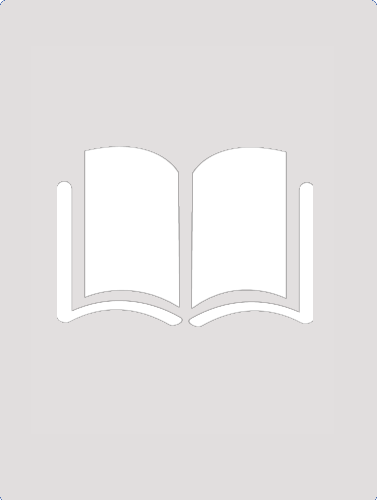- Table View
- List View
International Perspectives on the Design of Technology-supported Learning Environments
by Robert Glaser Stella Vosniadou Erik De Corte Heinz MandlIn recent years, the use of technology for the purposes of improving and enriching traditional instructional practices has received a great deal of attention. However, few works have explicitly examined cognitive, psychological, and educational principles on which technology-supported learning environments are based. This volume attempts to cover the need for a thorough theoretical analysis and discussion of the principles of system design that underlie the construction of technology-enhanced learning environments. It presents examples of technology-supported learning environments that cover a broad range of content domains, from the physical sciences and mathematics to the teaching of language and literacy. The emphasis in this book is not on the design of educational software but on the design of learning environments. A great deal of research on learning and instruction has recently moved out of the laboratory into the design of applications in instructional settings. By designing technology-supported learning environments instructional scientists attempt to better understand the theories and principles that are explicit in their theories of learning. The contributors to this volume examine how factors such as social interaction, the creation of meaningful activities, the use of multiple perspectives, and the construction of concrete representations influence the acquisition of new information and transfer.
International Proceedings on Advances in Soft Computing, Intelligent Systems and Applications
by K. Viswanath M. Sreenivasa Reddy Shiva Prasad K.M.The book focuses on the state-of-the-art technologies pertaining to advances in soft computing, intelligent system and applications. The Proceedings of ASISA 2016 presents novel and original work in soft computing, intelligent system and applications by the experts and budding researchers. These are the cutting edge technologies that have immense application in various fields. The papers discuss many real world complex problems that cannot be easily handled with traditional mathematical methods. The exact solution of the problems at hand can be achieved with soft computing techniques. Soft computing represents a collection of computational techniques inheriting inspiration from evolutionary algorithms, nature inspired algorithms, bio-inspired algorithms, neural networks and fuzzy logic.
International Program and Project Management — Best Practices in Selected Industries (Information Systems Engineering and Management #31)
by Narasimha Rao Vajjhala Kenneth David StrangThis book examines the latest best practices in international program and project management, offering invaluable insights across various industries. Edited by renowned experts, this book brings together a diverse range of case studies and research from leading scholars and practitioners worldwide. From a detailed macro-environmental analysis of contemporary project management to exploring the complexities of AI project management, each chapter highlights critical strategies, tools, and methodologies needed to tackle today's evolving challenges in program and project management. Topics such as ISO standards, ISO 21502, project management body of knowledge (PMBOK), risk management in high-complexity environments, stakeholder management, and agile business intelligence projects are discussed through practical case studies from industries ranging from fintech and biopharmaceuticals to public administration. This book is an essential resource for project managers, researchers, and industry professionals seeking to enhance their understanding of global project management dynamics and apply cutting-edge approaches across sectors. Chapter 7 is available open access under a Creative Commons Attribution 4.0 International License via link.springer.com.
International RILEM Conference on Synergising Expertise towards Sustainability and Robustness of Cement-based Materials and Concrete Structures: SynerCrete’23 - Volume 1 (RILEM Bookseries #43)
by Miguel Azenha Farid Benboudjema Dirk Schlicke Fragkoulis Kanavaris Agnieszka JędrzejewskaThis book highlights the latest advances, innovations, and applications in cement-based materials (CBM) and concrete structures, as presented by leading international researchers and engineers at the International RILEM Conference on synergizing expertise toward sustainability and robustness of CBM and concrete structures (SynerCrete), held in Milos Island, Greece, on June 14-16, 2023. The aim of the conference was to discuss and arouse progress in research, development, and application of CBM and structural concrete through combination of expertise from distinct fields of knowledge, such as performance-based design, 3D modeling for analysis/design, building information modeling, and even robotics, while keeping focus on multiscale approaches at time and spatial levels. It covers a diverse range of topics concerning alternative concrete formulations for adaptation to climate change, performance-based and multiphysics/multiscale design and innovative testing, structural health monitoring and maintenance management, integral BIM-based planning, and resource-responsible building. The contributions, which were selected by means of a rigorous international peer-review process, present a wealth of exciting ideas that will open novel research directions and foster new multidisciplinary collaborations. The two volumes encompass more than 200 original contributions in the field.
International RILEM Conference on Synergising Expertise towards Sustainability and Robustness of Cement-based Materials and Concrete Structures: SynerCrete’23 - Volume 2 (RILEM Bookseries #44)
by Miguel Azenha Farid Benboudjema Dirk Schlicke Fragkoulis Kanavaris Agnieszka JędrzejewskaThis book highlights the latest advances, innovations, and applications in cement-based materials (CBM) and concrete structures, as presented by leading international researchers and engineers at the International RILEM Conference on synergizing expertise toward sustainability and robustness of CBM and concrete structures (SynerCrete), held in Milos Island, Greece, on June 14-16, 2023. The aim of the conference was to discuss and arouse progress in research, development, and application of CBM and structural concrete through combination of expertise from distinct fields of knowledge, such as performance-based design, 3D modeling for analysis/design, building information modeling, and even robotics, while keeping focus on multiscale approaches at time and spatial levels. It covers a diverse range of topics concerning alternative concrete formulations for adaptation to climate change, performance-based and multiphysics/multiscale design and innovative testing, structural health monitoring and maintenance management, integral BIM-based planning, and resource-responsible building. The contributions, which were selected by means of a rigorous international peer-review process, present a wealth of exciting ideas that will open novel research directions and foster new multidisciplinary collaborations. The two volumes encompass more than 200 original contributions in the field.
International Recent Issues about ECDIS, e-Navigation and Safety at Sea: Marine Navigation and Safety of Sea Transportation
by Adam WeintritThe TransNav 2011 Symposium held at the Gdynia Maritime University, Poland in June 2011 has brought together a wide range of participants from all over the world. The program has offered a variety of contributions, allowing to look at many aspects of the navigational safety from various different points of view. Topics presented and discussed at th
International Relations in the Cyber Age: The Co-Evolution Dilemma (The\mit Press Ser.)
by David D. Clark Nazli ChoucriA foundational analysis of the co-evolution of the internet and international relations, examining resultant challenges for individuals, organizations, firms, and states.In our increasingly digital world, data flows define the international landscape as much as the flow of materials and people. How is cyberspace shaping international relations, and how are international relations shaping cyberspace? In this book, Nazli Choucri and David D. Clark offer a foundational analysis of the co-evolution of cyberspace (with the internet as its core) and international relations, examining resultant challenges for individuals, organizations, and states.The authors examine the pervasiveness of power and politics in the digital realm, finding that the internet is evolving much faster than the tools for regulating it. This creates a “co-evolution dilemma”—a new reality in which digital interactions have enabled weaker actors to influence or threaten stronger actors, including the traditional state powers. Choucri and Clark develop a new method for addressing control in the internet age, “control point analysis,” and apply it to a variety of situations, including major actors in the international and digital realms: the United States, China, and Google. In doing so they lay the groundwork for a new international relations theory that reflects the reality in which we live—one in which the international and digital realms are inextricably linked and evolving together.
International Scientific Conference Energy Management of Municipal Facilities and Sustainable Energy Technologies EMMFT 2018: Volume 1 (Advances in Intelligent Systems and Computing #982)
by Vera Murgul Marco PasettiThis book presents a collection of the latest studies on and applications for the sustainable development of urban energy systems. Based on the 20th International Scientific Conference on Energy Management of Municipal Facilities and Sustainable Energy Technologies, held in Voronezh and Samara, Russia from 10 to 13 December 2018, it addresses a range of aspects including energy modelling, materials and applications in buildings; heating, ventilation and air conditioning systems; renewable energy technologies (photovoltaic, biomass, and wind energy); electrical energy storage; energy management; and life cycle assessment in urban systems and transportation.The book is intended for a broad readership: from policymakers tasked with evaluating and promoting key enabling technologies, efficiency policies and sustainable energy practices, to researchers and engineers involved in the design and analysis of complex systems.
International Scientific Conference Energy Management of Municipal Facilities and Sustainable Energy Technologies EMMFT 2018: Volume 2 (Advances in Intelligent Systems and Computing #983)
by Vera Murgul Marco PasettiThis book presents a collection of the latest studies on and applications for the sustainable development of urban energy systems. Based on the 20th International Scientific Conference on Energy Management of Municipal Facilities and Sustainable Energy Technologies, held in Voronezh and Samara, Russia from 10 to 13 December 2018, it addresses a range of aspects including energy modelling, materials and applications in buildings; heating, ventilation and air conditioning systems; renewable energy technologies (photovoltaic, biomass, and wind energy); electrical energy storage; energy management; and life cycle assessment in urban systems and transportation.The book is intended for a broad readership: from policymakers tasked with evaluating and promoting key enabling technologies, efficiency policies and sustainable energy practices, to researchers and engineers involved in the design and analysis of complex systems.
International Symposium on Computer and Information Sciences
by Erol GelenbePapers from an October 2002 symposium describe research in areas including algorithms, artificial intelligence, computer graphics, computer networks, databases, evolutionary computation, graph theory, image processing, multimedia technology, software engineering, and software performance engineering
International Symposium on Intelligent Informatics: Proceedings of ISI 2022 (Smart Innovation, Systems and Technologies #333)
by Kuan-Ching Li Sabu M. Thampi Jayanta Mukhopadhyay Marcin PaprzyckiThis book constitutes thoroughly refereed post-conference proceedings of the 7th International Symposium on Intelligent Informatics (ISI 2022), from August 31 to September 1–2, 2022, Trivandrum, India. The revised papers presented are carefully reviewed and selected from several initial submissions. The scope of the Symposium includes AI, machine learning, cognitive computing, soft computing, security informatics, data science, computer vision, pattern recognition, intelligent software engineering, intelligent networked systems, IoT, cyber-physical systems, and NLP. The book is directed to the researchers and scientists engaged in various fields of intelligent informatics.
International Symposium on Mathematics, Quantum Theory, and Cryptography: Proceedings of MQC 2019 (Mathematics for Industry #33)
by Tsuyoshi Takagi Masato Wakayama Keisuke Tanaka Noboru Kunihiro Kazufumi Kimoto Yasuhiko IkematsuThis open access book presents selected papers from International Symposium on Mathematics, Quantum Theory, and Cryptography (MQC), which was held on September 25-27, 2019 in Fukuoka, Japan. The international symposium MQC addresses the mathematics and quantum theory underlying secure modeling of the post quantum cryptography including e.g. mathematical study of the light-matter interaction models as well as quantum computing.The security of the most widely used RSA cryptosystem is based on the difficulty of factoring large integers. However, in 1994 Shor proposed a quantum polynomial time algorithm for factoring integers, and the RSA cryptosystem is no longer secure in the quantum computing model. This vulnerability has prompted research into post-quantum cryptography using alternative mathematical problems that are secure in the era of quantum computers. In this regard, the National Institute of Standards and Technology (NIST) began to standardize post-quantum cryptography in 2016. This book is suitable for postgraduate students in mathematics and computer science, as well as for experts in industry working on post-quantum cryptography.
International Taxation Law in Sports Events: An Income Tax Analysis
by Alara Efsun YazıcıoğluThis book is the first academic contribution that deals with international taxation of income sources from sports events.Using an interdisciplinary approach, with in-depth analysis of both sports law and international tax law, it is notably the first academic work to conduct a thorough analysis in the fields of international taxation of eSports, sports betting as well as illegal/unlawful income sources that may be obtained in relation to a sporting event, such as kickback payments. After describing the general methodologies of income tax and VAT from an international standpoint, defining key terms such as ‘eSports’ and ‘bidding procedure’, the book examines in detail the taxation of the services that are rendered and the goods that are sold, thereby the income obtained, in relation to an international sports event from both income tax and VAT perspectives. Also analysed are government funding in the sports sector, along with its taxation modalities, as well as specific tax exemption regulations enacted for the purposes of mega sporting events. Highlighting the absence of an acceptable level of certainty in the field of taxation of international sports events, the work makes pertinent suggestions as to the future of international sporting event taxation law.With international appeal, this comprehensive book constitutes essential reading for tax and sports law scholars.
International Technology Robotics Applications
by Ignacio González AlonsoThis book presents the latest scientific research related to the field of Robotics. It involves different topics such as biomedicine, energy efficiency and home automation and robotics. The book is written by technical experts and researchers from academia and industry working on robotics applications. The book could be used as supplementary material for courses related to Robotics and Domotics.
International Telecommunications Conference: Proceedings of the ITelCon 2017, Istanbul (Lecture Notes in Electrical Engineering #504)
by Ali Boyaci Ali Riza Ekti Muhammed Ali Aydin Serhan YarkanThis book collects one of the global premier scientific gatherings on telecommunications, signal processing, data networks, security, and optimization. It presents the proceedings of the International Telecommunications Conference 2017 (ITelCon 2017), held in Istanbul, Turkey from December 28 to 29, 2017. The proceedings include state-of-the-art studies that highlight major advances in the field of telecommunications and related branches. In addition, some of the contributions form the basis for 5G and beyond studies and standardization processes. The ITelCon conference brings together industry and academia participants from around the globe and promotes research, development, and applications in the field of telecommunications. It includes a far-reaching program supported by a variety of technical tracks on research, development, technology, design, services, and applications. The primary audience of ITelCon includes academics, experts and professionals from industry, as well as researchers in the field of telecommunications and relevant subfields.
International e-Conference of Computer Science 2006: Additional Papers from ICNAAM 2006 and ICCMSE 2006
by Theodore Simos Georgios PsihoyiosLecture Series on Computer and on Computational Sciences (LSCCS) aims to provide a medium for the publication of new results and developments of high-level research and education in the field of computer and computational science.In this series, only selected proceedings of conferences in all areas of computer science and computational sciences wil
International e-Conference on Computer Science (IeCCS 2005)
by Theodore SimosThe aim of IeCCS 2005, which was held in May 2005, was to bring together leading scientists of the international Computer Science community and to attract original research papers. This volume in the Lecture Series on Computer and Computational Sciences contains the extended abstracts of the presentations. The topics covered included (but were not limited to): Numerical Analysis, Scientific Computation, Computational Mathematics, Mathematical Software, Programming Techniques and Languages, Parallel Algorithms and its Applications, Symbolic and Algebraic Manipulation, Analysis of Algorithms, Problem Complexity, Mathematical Logic, Formal Languages, Data Structures, Data Bases, Information Systems, Artificial Intelligence, Expert Systems, Simulation and Modeling, Computer Graphics, Software Engineering, Image Processing, Computer Applications, Hardware, Computer Systems Organization, Software, Data, Theory of Computation, Mathematics of Computing, Information Systems, Computing Methodologies, Computer Applications and Computing Milieu.
Internationalising Higher Education and the Role of Virtual Exchange (Routledge Research in Higher Education)
by Robert O'DowdThis volume introduces Virtual Exchange (VE) as an innovative form of online intercultural learning and investigates the myriad of ways VE is being carried out across universities, ultimately arguing for its integration into university internationalisation policies and course curricula. Against the backdrop of increased digitalisation initiatives throughout universities given the effects of the pandemic, chapters focus not only on providing new research findings, but also on providing a comprehensive introduction and argumentation for the use of VE in university education and also in demonstrating how it can be put into use by both university decision-makers and educators. Reviewing the limitations of the activity, this timely work also fundamentally posits how VE and blended mobility more broadly could be developed in future higher education initiatives. This book will be of interest to researchers, academics, scholars, and students involved with Open & Distance Education and eLearning, approaches to internationalisation in education, and the study of higher education more broadly. Those interested in innovative methods for teaching and learning, as well as educational research, will also benefit from this volume.
Internet
by Lorenzo Cantoni Stefano TardiniFrom music to gaming, information gathering to eLearning; eCommerce to eGovernment, Lorenzo Cantoni and Stefano Tardini's absorbing introduction considers the internet as a communication technology; the opportunities it affords us, the limitations it imposes and the functions it allows. Internet explores: the political economy of the internet hypertext computer mediated communication websites as communication conceptualizing users of the internet internet communities and practices. Perfect for students studying this modern phenomenon, and a veritable e-feast for all cyber junkies.
Internet Access in Vehicular Networks
by Haibo Zhou Xuemin (Sherman) Shen Wenchao XuThis book introduces the Internet access for vehicles as well as novel communication and computing paradigms based on the Internet of vehicles. To enable efficient and reliable Internet connection for mobile vehicle users, this book first introduces analytical modelling methods for the practical vehicle-to-roadside (V2R) Internet access procedure, and employ the interworking of V2R and vehicle-to-vehicle (V2V) to improve the network performance for a variety of automotive applications. In addition, the wireless link performance between a vehicle and an Internet access station is investigated, and a machine learning based algorithm is proposed to improve the link throughout by selecting an efficient modulation and coding scheme.This book also investigates the distributed machine learning algorithms over the Internet access of vehicles. A novel broadcasting scheme is designed to intelligently adjust the training users that are involved in the iteration rounds for an asynchronous federated learning scheme, which is shown to greatly improve the training efficiency. This book conducts the fully asynchronous machine learning evaluations among vehicle users that can utilize the opportunistic V2R communication to train machine learning models. Researchers and advanced-level students who focus on vehicular networks, industrial entities for internet of vehicles providers, government agencies target on transportation system and road management will find this book useful as reference. Network device manufacturers and network operators will also want to purchase this book.
Internet Annoyances
by Preston GrallaWhat began as an intrepid U.S. Government initiative in the early 1970's has turned into a global way of life. Indeed, with more than 500 million current users (and counting), the Internet has revolutionized the way societies function the world over. From dating and shopping online, to conducting informational research, to communicating via email, today seemingly everyone uses the Internet for one purpose or another. How, then, can something so vast and powerful be defiled by something as trivial as spam? It's true. The fact remains that despite the leading-edge technological sophistication fueling the Net, there are still many related annoyances that complicate and tarnish the Internet experience. And it doesn't matter if you're a homemaker in search of a fresh chicken recipe, or a civil engineer researching plans for a new skyscraper, the problems are the same. Internet Annoyances understands the universal nature of the Internet and strives to make its use as stress-free as possible. This insightful guide shows you how to overcome the most annoying Internet-related quirks, bugs, and hassles. You'll learn how to make a seamless connection, thwart would-be hackers, ensure greater security while surfing, eliminate pop-up ads, maximize online services, conduct more effective Google searches, better utilize digital media (music and video), and much more. In addition, Internet Annoyances discusses how to design and host a personal web site something once thought of as only possible for the technically gifted. Topics like blogs, domain names, setup, HTML, fonts, and graphics and are all dissected and analyzed for easy consumption. Unlike other books on the subject, Internet Annoyances assumes readers already possess a working knowledge of the Internet. By fully recognizing the experience level of today's Internet culture, author Preston Galla is able to cut immediately to the chase and not waste time on the more obvious points. Internet Annoyances , therefore, is a quick read that presents succinct solutions for the many glitches that still populate the Internet experience.
Internet Applications in Euromarketing
by Lynn R. Kahle Erdener KaynakExplore Internet marketing from cross-cultural and cross-national perspectives! This book examines cutting-edge theory and practice on Internet marketing, putting the latest research on the best ways to exploit this interactive advertising medium in your hands. In Internet Applications in Euromarketing, scholars from Europe and the United States examine essential facets of Internet use, both as a means of product promotion and as a facilitator of consumers? purchasing decisions. Internet Applications in Euromarketing considers the effectiveness of combining Web advertising with traditional media, looks at ways to make banner ads pay off, highlights techniques for reaching older consumers via the Internet, shows how to take advantage of online word-of-mouth advertising, and more! The handy charts and tables in this well-referenced book make important points of information easy to access and understand. Internet Applications in Euromarketing looks in-depth at what works and what doesn?t, addressing the questions on marketers? minds (and some that many haven?t thought of yet), including: Where is a company?s marketing money best spent?what are the media effects for Internet exposure vs. television and print? Is it useful to mention a price, a rebate, or a gift to encourage the Internet user to move from the banner?s host site to the brand?s site? What are the Internet habits and preferences of seniors, and what are the best ways to reach them? Are banner ads that are disguised as messages from the user?s operating system more effective than those that simply appear as advertising? How can we generate word-of-mouth Internet communication?via e-mail, newsgroups, bulletin boards, chat rooms, etc.?and establish credibility? What are the advantages of online discussions over traditional focus groups?
Internet Applications of Type II Uses of Technology in Education
by Cleborne D. Maddux D. LaMont JohnsonGive your students a powerful learning resource-the Internet!The Internet, though brimming with potential, is still vastly underused as a teaching resource. Internet Applications of Type II Uses of Technology in Education gives teachers new strategies for the Internet&’s use as a dynamic educational resource. Where Type I teaching applications technologically mimic the procedures previously used by teachers, Type II teaching applications involve innovative thinking in the use of technology in learning. Using Type II applications with the Internet, students are actively empowered to look to its use as an effective partner in their learning process. This book clearly reviews several Type II teaching applications and integrative software for use in all educational levels, including Internet videoconferencing, instant messages, WebQuests, and WebCT.Though now readily available, even those schools with the capability fail to effectively integrate computer and Internet technology into meaningful classroom activities. Using the Internet as a teaching and learning tool offers a flexibility that can be extremely effective. Internet Applications of Type II Uses of Technology in Education clearly shows how some creative educators have implemented inventive Type II applications in their teaching plans to give their students a more enriching learning experience.Internet Applications of Type II Uses of Technology in Education explores: critically evaluating Web site information how perceptions and behaviors change when Internet access becomes universally available Internet2 Videoconferencing integrating online communication into courses utilizing computer-mediated communication (CMC) tools structured online class discussions using Instant Messenger (IM) increasing vocabulary through software and online texts online learning in second-language acquisition (SLA) a project in New Zealand in which teachers and students learn Web design with the help of an external expert WebQuests as a Type II application WebCT as a Type II application achievement testing through the computer the Global Forum on School Leadership (GFSL) as a Type II applicationInternet Applications of Type II Uses of Technology in Education is a valuable, idea-generating resource for all academics working in information technology and education, and for K-12 teachers and administrators at all levels.
Internet Book Piracy: The Fight to Protect Authors, Publishers, and Our Culture
by Gini Graham ScottThe international battle against Internet pirates has been heating up. Increasingly law enforcement is paying attention to book piracy as ebook publishing gains an ever-larger market share. With this threat to their health and even survival, publishers and authors must act much like the music, film, and software giants that have waged war against pirates for the past two decades. Now, The Battle against Internet Piracy opens a discussion on what happens to the victims of piracy. Drawing from a large number of interviews-from writers, self-publishers, mainstream publishers, researchers, students, admitted pirates, free speech advocates, attorneys, and local and international law enforcement officials-the text speaks to such issues as: Why pirates have acted and how they feel about it The conflict over constitutional rights and piracy The current laws surrounding Internet piracy Examples of cases taken against some pirates Alternatives to piracy Personal experiences of being ripped off The ways piracy affects different industries and how they’ve respondedAuthor Gini Graham Scott prepares readers to arm themselves against these modern perils by learning about copyright, infringement, and how to prevent, combat, and end book piracy.Allworth Press, an imprint of Skyhorse Publishing, publishes a broad range of books on the visual and performing arts, with emphasis on the business of art. Our titles cover subjects such as graphic design, theater, branding, fine art, photography, interior design, writing, acting, film, how to start careers, business and legal forms, business practices, and more. While we don't aspire to publish a New York Times bestseller or a national bestseller, we are deeply committed to quality books that help creative professionals succeed and thrive. We often publish in areas overlooked by other publishers and welcome the author whose expertise can help our audience of readers.
Internet Branding For Lawyers: Building The Client-centered Website
by Jeff LantzCovering methods applicable to firms serving individuals as well as firms serving businesses, this reader-friendly guide shows how to create a brand and a website for a law firm. Lantz, a consultant in brand creation and website development who holds an MBA in finance, advises readers to focus on the customer perspective: how will you help me and how much will it cost. The book begins by explaining the increased importance of branding in today's information age, then explains how to build a brand around the law firm's practices and how to communicate the brand through website content and design. The final section of the book is given over to technical details and decisions related to areas such as content management systems, choosing a website developer, search optimization, domain names, and servers and website hosting. The book includes many bullets and checklists, along with b&w photos, screenshots, and examples of logos. Annotation ©2012 Book News, Inc. , Portland, OR (booknews. com)
